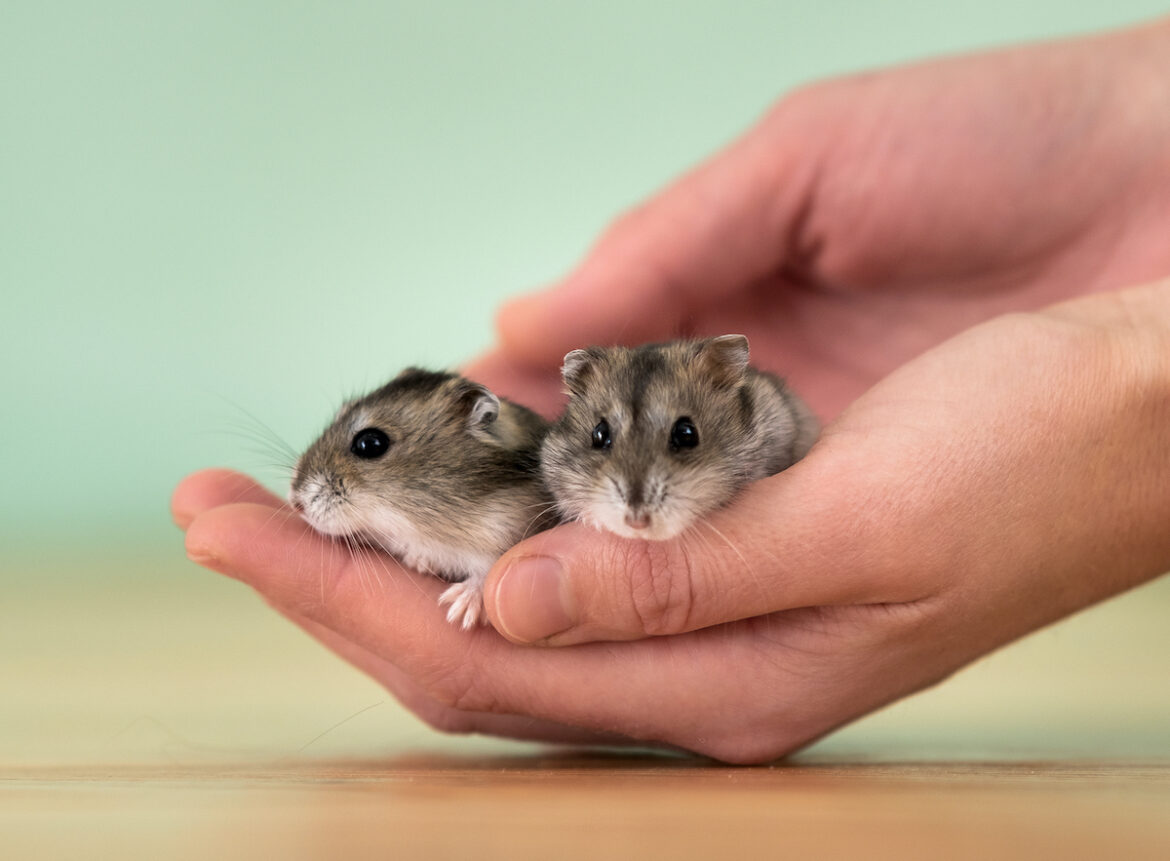Hamsters make great pets for families, and they can be fairly easy to care for too. If you are thinking of bringing a hamster home to join your own family, you do have to do some research to know what you are in for, and how big hamsters actually get.
You would want to give your hamster the perfect enclosure to live in, with enough space and hiding spots to keep them happy. To do this, you really need to know how big they will be when fully grown.
How big do hamsters get? Adult hamsters can grow to various sizes depending on breed and gender. They can grow to 2 inches or up to 7 inches and can weigh anything from 0.6 ounces to 6 ounces. All hamsters are small, but how small they are does vary.
Different breeds of hamsters grow to different sizes, and whether a hamster is a male or female has some effect on how large they grow. With the different breeds of hamsters, you can choose somewhat the size that you want your hamster to grow to.
Read on to find out more about what determines a hamster’s size, how big they get, and the different breed sizes!
What Has An Effect On A Hamsters Size?
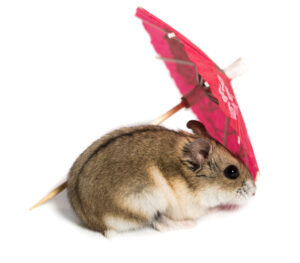
There are a few different factors that determine how big a hamster may grow, and knowing these different factors will help you determine how big your hamster might grow, or help you pick out the right enclosure for your hamster!
Hamster Breed
The breed of the hamster is the number one determining factor in how big a hamster grows.
There are quite a few different hamster breeds, and each of them has different size ranges. Some hamster breeds only grow to a tiny size, while others can grow quite large.
The best way to know how big your hamster will get is to learn what type of breed they are and to check how big that particular breed grows.
Hamster Gender
Other than the breed playing a big determining role in how big the hamster gets, the gender of the hamster will also play a role.
Generally, male hamsters are larger than female hamsters, but this can vary at times. You might have a rare case where your female hamster is larger than the male, but most of the time the male hamsters are on the larger side.
Size Of The Litter
While it plays a small role, the size of the litter can also determine how large a hamster might grow. A smaller litter usually produces larger hamsters, as there is little competition early on. Larger litters of hamsters usually produce smaller hamsters, as there is not as much nourishment available to the babies.
Genetics
Like with all animals, genetics will always have an effect on a hamster’s traits. If two small hamsters breed, it is likely that their baby will be small too. If two larger hamsters breed, then there is a better chance of their babies being larger.
There are always exceptions to this, so you should not just rely on this to try and figure out how big your hamster might grow.
Hamster Breeds
There are quite a few popular hamster breeds that people choose to keep as pets, and all of these breeds have different growth ranges.
The five most popular hamster breeds are Campbell’s Russian hamsters, Roborovski hamsters, Chinese hamsters, winter white hamsters, and Syrian hamsters. Read on to find out the different sizes that these hamsters grow to.
1. Campbell’s Russian Hamsters (Dwarf Hamsters)
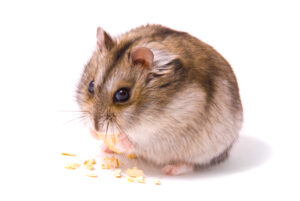
Campbell’s Russian hamsters, also known as Russian hamsters or Russian dwarf hamsters, are popular pets, but they are also a breed of hamsters found in the wild. They can be found in the wild in China, Russia, Mongolia, and Kazakhstan.
In the wild, these hamsters only grow to around 3 inches long, as they are not offered as much readily-available nutrition as those kept in captivity.
Campbell’s Russian hamsters kept as pets can grow between 2-4 inches, and can weigh between 1.5-2 ounces. This is quite a small size, which makes them a popular choice of breed for people who are looking for a smaller hamster.
A Campbell’s Russian hamster will be fully grown when it is around 3 months old. They can already breed from 4 weeks old, once they are fully weaned, but they will not be fully grown at this age yet.
Most Campbell’s Russian hamsters will live just past 2 years old in captivity when cared for well. They have a white belly, grey-brown fur, and a dark stripe down their back.
2. Roborovski Hamsters
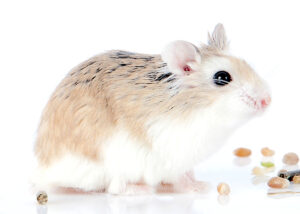
Roborovski hamsters are the smallest hamsters, and this makes them quite popular for pet owners who want a tiny, pocket-sized pet.
A Roborovski hamster will only grow to between 1.8-2 inches long, which is tiny compared to some other breeds. They will weigh between 0.7-0.9 ounces, which once again is considerably small.
While this small size might be appealing to many, it does come with some problems. The cage that the hamster is given needs to be made of glass or have bars that this tiny hamster cannot fit through, and they need to be given toys and exercise equipment that would be fine for their small size to use.
A Roborovski hamster will be fully grown at the 3-month mark and can start breeding at around 5 weeks, so it does help to separate males and females from early on.
Roborovski hamsters can be a little bit shy at first, but these curious little hamsters will love to play and explore when they get used to their new family.
3. Chinese Hamsters
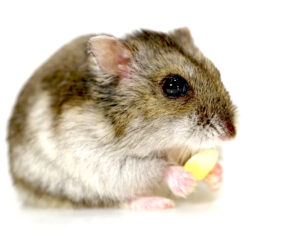
Chinese hamsters are a very popular hamster choice for families, and they are also found in the wild in China!
These are fairly average size hamsters, growing to between 3.2 to 5-inches in total, and fully grown will weigh between 1.1 to 1.6 ounces. They are on the smaller side but are bigger than some of the really small breeds.
To tell a Chinese hamster from other hamsters, you would need to look at their tail. Chinese hamsters have a long tail compared to other breeds, almost resembling a mouse more than a hamster.
A Chinese hamster will be fully grown at between 2-3 months old, but it will be able to breed before this. Kept healthy and in the right conditions, this hamster can live for up to 2 years in captivity.
4. Siberian Hamsters (Winter White Hamsters)
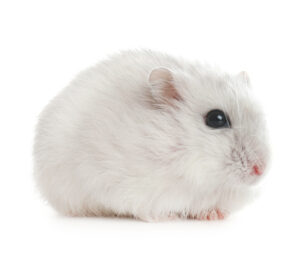
Winter white hamsters are closely related to Campbell’s Russian hamsters and have a similar appearance and size to them as well. These hamsters are also known as Siberian hamsters.
A winter white hamster will grow to 2.7-3.5 inches long and will weigh between 0.7-1.6 ounces. They are small hamsters and will be fully grown at around 3 months of age.
Like other breeds, they will be able to breed from 4 weeks old, and if you don’t want baby hamsters, then you should separate males and females from a young age.
A winter white hamster makes a great pet, as they tend to be tame and easy to care for. Their fur changes in different seasons slightly, and in the wild, their fur changes to white in the winter.
In the warmer seasons, their fur is quite a dark grey, with a darker stripe down their back.
5. Syrian Hamsters (Teddy Bear Hamster)
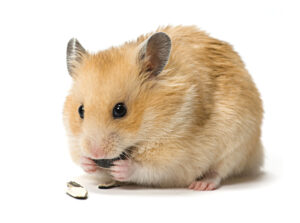
Syrian hamsters are large hamsters and are great for families who want a bigger hamster that will thrive in their own big cage, and which can be handled by younger children without worry.
These hamsters are also known as golden hamsters or teddy bear hamsters.
Being larger hamsters, Syrian hamsters can grow to between 5-7 inches and weigh up to between 5.1-6 ounces.
A Syrian hamster will be fully grown when around 3 months old, and both females and males will be able to breed from 4 weeks old.
You will know that a Syrian hamster is reaching maturity when their markings become clearer, and their darker fur starts to show through.
Kept in captivity, Syrian hamsters can live between 2-3 years, which is quite a long time. At 2 years old, they will be considered quite old, and will begin to feel their old age, and will start to decline in health and movement from there.
Hamster Size Chart
To help you better see the difference between the size of the hamster breeds, here is a quick chart displaying them, and some other hamster breeds that you might come across too!
| Breed | Size | Weight |
| Campbell’s Russian Hamster | 2-4 inches | 1.4-2oz |
| Roborovski Hamster | 1.7-2 inches | 0.6-0.9oz |
| Chinese Hamster | 2.8-4.6 inches | 0.7-1.2oz |
| White Winter Hamster | 2.7-3.5 inches | 2.5-3.2oz |
| Syrian Hamster | 5-7 inches | 5.1-6oz |
| Sokolov’s Hamster | 3-4.5 inches | 0.8-1.2oz |
| Armenian Hamster | 3.3-4.7 inches | 1-2oz |
As you can see from the charts, hamsters are small pets, but the different breeds all have their own growth ranges, and knowing these different ranges does help you choose the pet that is best for you!
Choosing The Right Cage For Your Hamster
The size of your hamster needs to be taken into consideration when choosing the right cage for them, as smaller hamsters might be able to escape through wider bars, and large hamsters might find smaller cages quite constricting.
When you first bring your hamster home, they will seem very small, as they will most likely still be young. Don’t let their size when they are young determine the size you cage you buy them, and instead, look to the average breed size for guidance.
Choosing a hamster cage that is too small can cause your hamster quite a bit of stress and can even cause health problems later on. They might become frustrated with the lack of space and this could lead to bad behavior such as chewing and trying to destroy their cage.
Syrian hamsters, which are around some of the largest that you could keep at home, would require a cage around 24 x 12 inches at a minimum. The cage should be at least 12-inches high.
Even smaller hamsters should be in cages around this size, as they would be happier in a bigger cage than they would be in a smaller cage, and you can never be sure of the exact size they might grow to be!
It is best to chat with the breeder you are getting the hamster from to get some advice from them if this is the first hamster you are bringing home, to ensure that you can give them the best enclosure and care possible.
Do All Hamster Breeds Make Good Pets?
There are about 19 different breeds of hamsters in the world, but only around 5 have been fully domesticated to be kept as pets.
The breeds of hamsters that make the best pets include Campbell’s Russian hamsters, Chinese hamsters, Syrian hamsters, winter white hamsters, and Roborovski hamsters.
It is always a good idea to do some research on the breed you are considering bringing home, as they all have different traits and behaviors. The above five make good pets, with each of them having their own personality traits such as shyness or some being a little more active.
Most of the hamster breeds which have been domesticated as pets like to burrow to feel safe, so you will need to provide them with clean and healthy bedding to do so. The bedding you use should be safe for them and easy to clean for you, so it is worth doing your research on that as well.
How Do I Know When My Hamster Is Fully Grown?
Most hamsters will be fully grown between 3-4 months old. It can be difficult to know the age of your hamster if the breeder isn’t sure, but if you have had them for a few months, it is safe to assume that they are fully grown.
Hamsters can also start breeding at around 4-5 weeks, so it is worth separating males and females if you do not want more hamster litters!
Final Thoughts
Hamsters are small pets, but the different breeds of hamsters do grow to different sizes, and you will need to know what breed you have to determine how big your hamster might get.
Other than the breed of the hamster determining how large it grows, gender, litter size, and genetics play a role as well.
Make sure that you anticipate the size of the hamster you are bringing home, to be able to care for them in the best way possible and to give them the right size home to call their own!
Related Questions
How do I know what breed my hamster is?
Unless the breeder lets you know what breed of hamster you are given, it can be a bit of guesswork to work out the breed. You can take the coat color and length, size, traits, and behavior patterns of the hamster into consideration to try and work out the breed, but it is not always easy for novices.
Do hamsters like to be held?
Hamsters do not always like to be held and prefer to stay on their own in their cage and burrow down into their bedding for comfort.
Do hamsters need to be bathed?
It is not a good idea to bathe your hamster, as it could stress them out, and if hamsters become stressed, it could be dangerous for their health. Hamsters self-groom and keep themselves clean. For more information, check out our article: Can Hamsters Get Wet?
Up Next: Can Hamsters Drink Tap Water?
